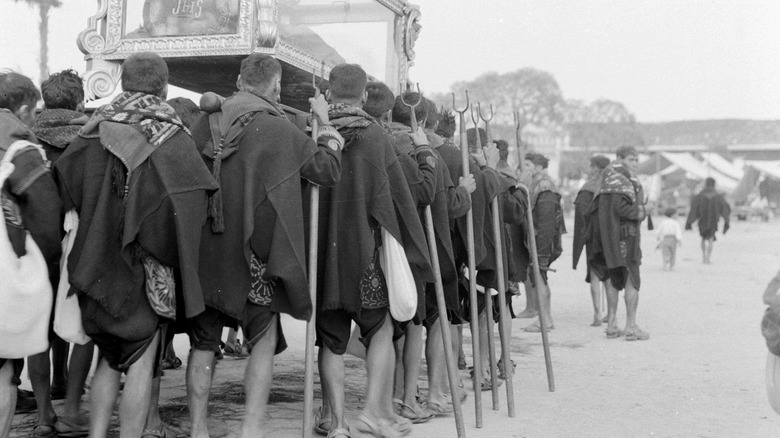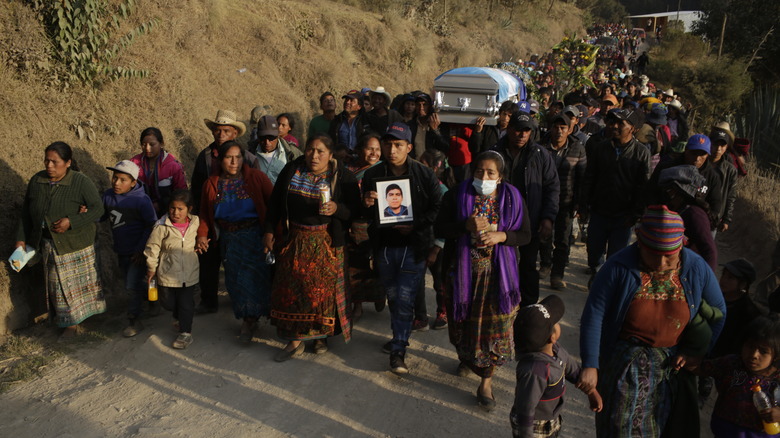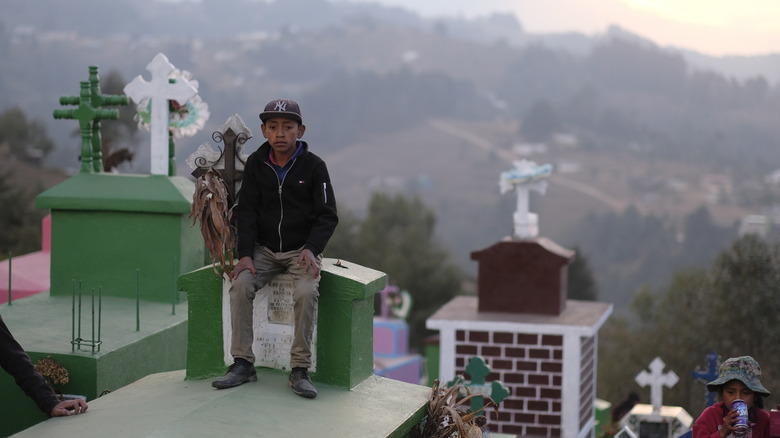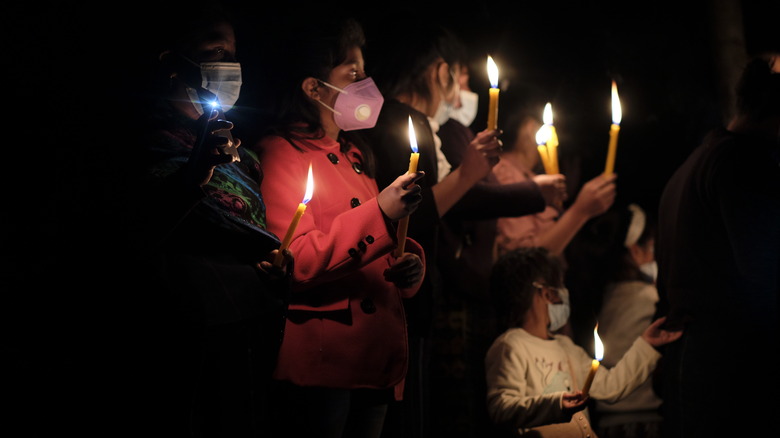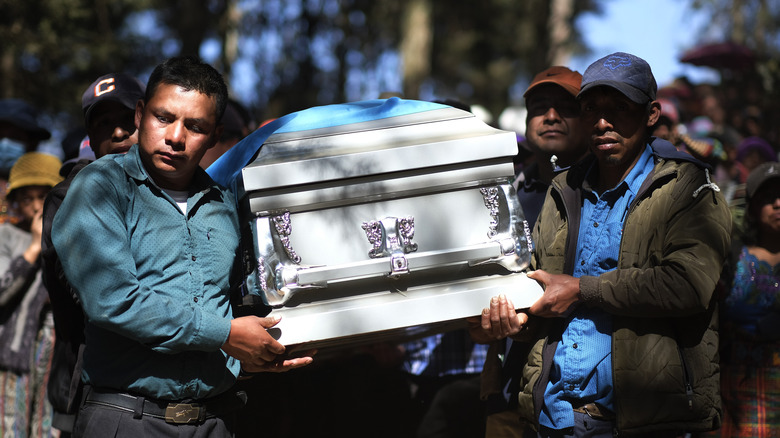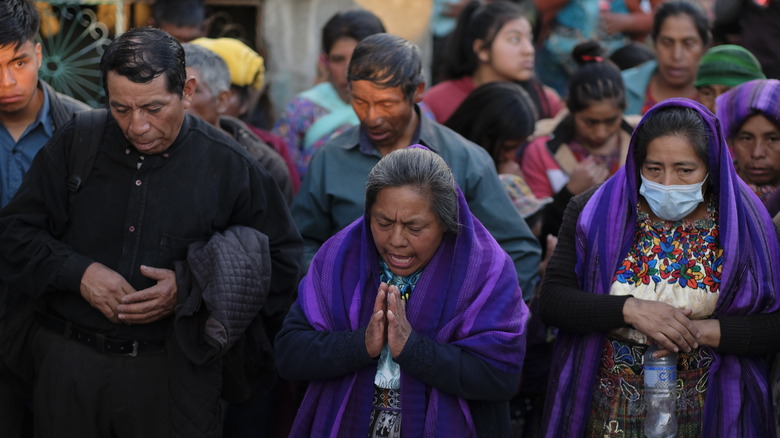The Untold Truth Of The Death Squad Diary
In 1960, a brutal civil war broke out in the small Latin American nation of Guatemala. It would last 36 years and claim hundreds of thousands of lives. The war was one of the effects of the growing tension between the United States and the Soviet Union, and communist versus authoritarian factions in Guatemala devolved into violence following a 1954 coup d'état. The coup had been in part encouraged by the U.S. government after the left-wing President Jacobo Arbenz moved to nationalize American-owned companies, per PBS.
In total, the Center for Justice and Accountability estimates that around 200,000 people were killed during the war. The CJA noted that while left-wing guerrilla fighters participated in violence and murder, a vast majority of the extrajudicial killings were carried out by the military or military-adjacent groups. The indigenous Mayan communities were hit particularly hard, accounting for 83% of all fatalities. The Mayan population had originally been a source of grass-roots support for Marxist guerrilla fighters — in part because many governmental policies hurt poor and rural farmers. As the war raged on, the idea that the Mayans were communist sympathizers became embedded into the ideology of right-wing figures, even if not necessarily true.
The civil war was known for its kidnappings
In 1966, civilian rule was restored to Guatemala when Julio César Méndez Montenegro, a former law professor, was elected president over the military-backed candidate. However, instead of easing tensions, it only made the situation worse by escalating the military's counterinsurgent operations while empowering more liberal factions. In fact, the Inter-American Human Rights Commission released a report that went so far as to claim that the time from 1966 onward was a "state of terror," meaning that the country was subject to the most extreme level of violence.
The military and other paramilitary organizations targeted groups that had either ties or perceived sympathies to communism. Particular targets included workers' unions, journalists, and student activists. Many historians believe that the start of the "state of terror" actually occurred a few days before the election of Méndez Montenegro. On March 6, 1966, 28 union members and leaders of the Guatemalan Workers Party disappeared after being arrested during a clandestine meeting. It was later revealed that they had been tortured before being killed.
This soon became a pattern in Guatemala: People would disappear without warning, with families and friends left with no explanation and no closure. Most assumed that their loved ones were dead.
Though the Guatemalan government always denied having any knowledge or involvement with the disappearances, a book known as the "Death Squad Diary," or "Diario Militar," revealed that this was not true.
The diary was a creepy catalog of murder
The Death Squad Diary was a 74-page record that detailed 183 political opponents who were abducted, forcibly disappeared, or executed by state agents from 1983 to 1986. The journal looked like something a villain in a horror movie would have. Each name was written with an accompanying passport or driver's license photo in a morbid reminder of the person that suffered each horrifying fate. Other details written in each entry included information such as occupation, date of seizure, and their alleged connections to left-wing groups. At the bottom of each entry was coded language that referred to the fate of each name. The use of coded language was a way for the paramilitary groups to feign deniability in the event that the document became public. Since its publication, experts have been able to decipher what the terms and codes mean, allowing families and friends of some of the victims to learn when and where their loved ones were killed and buried.
This has been huge as it has allowed police to find the remains of around a dozen casualties. Before, many of the victims' families had not received any closure because most individuals who disappeared were rarely found. During the civil war, bodies would be discovered after being stripped of all papers and tortured or disfigured to make identification nearly impossible. Sadly, there are bodies that will likely never be found, as some criminals disposed of the corpses by sinking them into the ocean or even throwing them into volcanoes, as noted in a report published by the Guatemalan government.
All about the victims of the Death Squad Diary
Interestingly, many of the victims in the diary were a different profile from the casualties of the decade before. While most of the previous targets had existed in rural communities that had been accused of having ties to Marxist guerrilla fighters, the victims listed in the Death Squad Diary generally lived in Guatemala City and were students, politicians, and even religious leaders. However, there was a reason behind the discrepancy. While previous attacks had been carried out by pro-government paramilitary groups, the new ones had actual ties to the regime. In fact, some of the kidnapped victims were taken to military bases or police stations — signs that members of the government were openly supporting such actions.
Though the vast majority of those named in the Death Squad Diary were killed, there were some survivors. Those that lived were consistent in their descriptions of the kidnappings.
One man named Sosa Ramos said that he had been "brutally beaten, whipped, deprived of water, tortured with electric shocks, and hung by his feet for long periods of time." The torture wasn't just physical, but emotional as well. Ramos noted that he could "hear the screams of others being tortured nearby," adding to the traumatic experience.
The diary had never meant to be released, but it was leaked in 1999 to Kate Doyle of the National Security Archive, a non-governmental organization based in the United States, and Doyle published the documents in Harper's Magazine. The United States has since authenticated the diary's veracity.
The men behind the atrocities will hopefully face justice soon
Most Guatemalans had assumed that the perpetrators who committed the atrocities through the 1970s and 1980s would never face consequences for their actions. However, 12 men were arrested in late May and early June because of their participation in the Death Squad Diary killings, per the National Security Archive.
The most high profile of the dozen is retired General Marco Antonio González Taracena. González Taracena served as Guatemala's Minister of Defense in 1995 in addition to the former chief of the espionage unit known as the Archivo. Another noted figure among the arrested is retired army officer Colonel Jacobo Esdras Salán Sánchez. In addition to the 12 men currently in custody, five other suspects remain in hiding and have been named fugitives of the state.
The trials of the alleged Death Squad members will be open to the public and will also be live-streamed in a move that both promotes transparency and gives more access to families, friends, and colleagues of the deceased.
There are still some obstacles in the fight for justice
Though 12 individuals who participated in the extrajudicial kidnapping and killing of civilians have been arrested, the fight for justice is far from over. Since news of the arrests broke, several right-wing politicians and veterans' groups have voiced their support for the dozen men. For example, Alvaro Arzu, former congressional human rights commission president, called them "war heroes" and said that "they defended the country's sovereignty and saved us from communism" in a tweet earlier this summer.
Similarly, a group of lawmakers proposed a bill that would essentially abolish the prosecution of crimes committed during the civil war era. The bill would also be retroactive, meaning that it would release anyone awaiting trial for similar crimes.
That said, this is not the first time that Guatemala has attempted to pass such legislation. Though the previous attempt passed its first congressional reading in 2017, it was later struck down by the Guatemalan courts. The amnesty bill also brought on an onslaught of civilian protests and international condemnation for the Guatemalan government, with the United Nations openly declaring that the amnesty law would violate Guatemala's obligations to defend human rights, per the Los Angeles Times.
However, those who have sought justice remain hopeful, stating that they chose to focus on the progress their movement has made.
"We finally see the result of everything we have done," explained Marcia Mendez, whose sister disappeared in 1984, to Al Jazeera.
"We are both sad and happy," she added. "We have cried a lot, too, out of joy, out of rage, out of all kinds of emotions."
